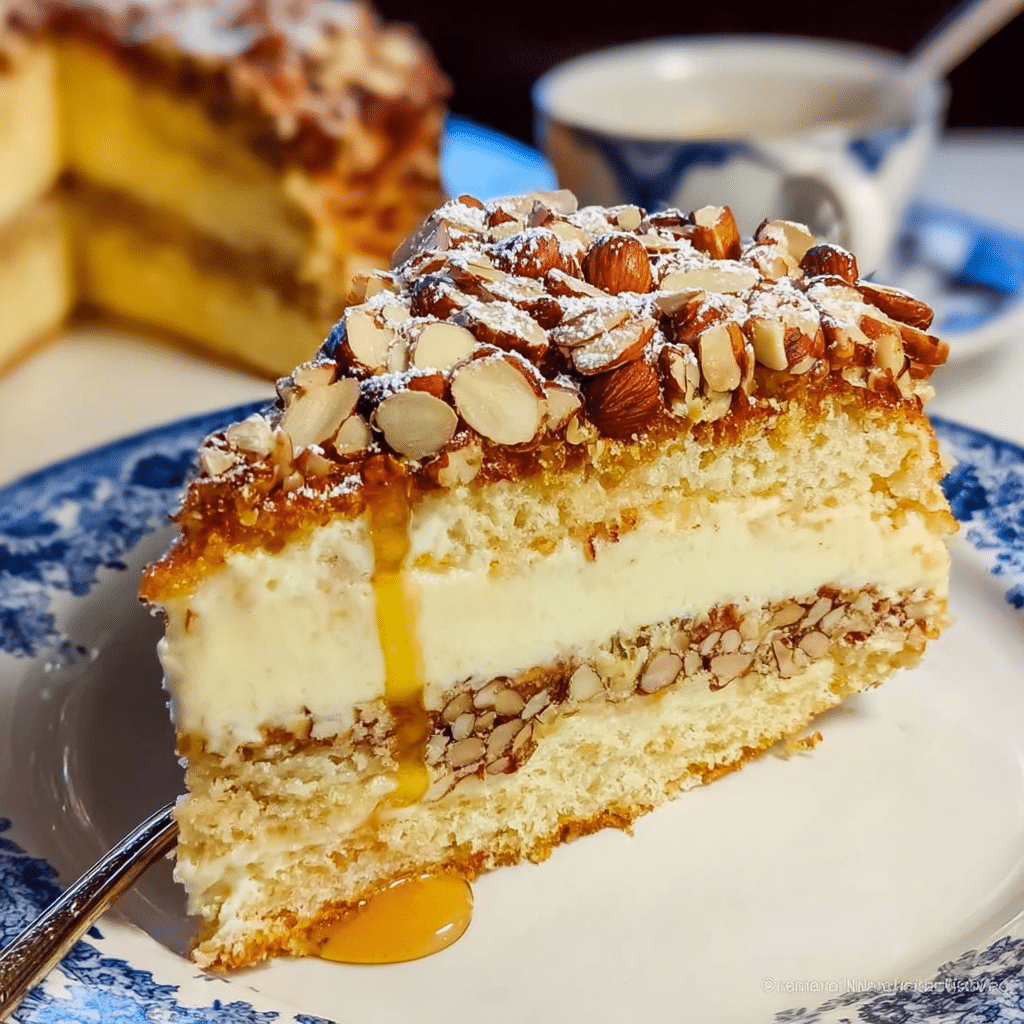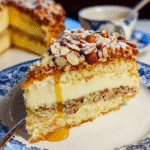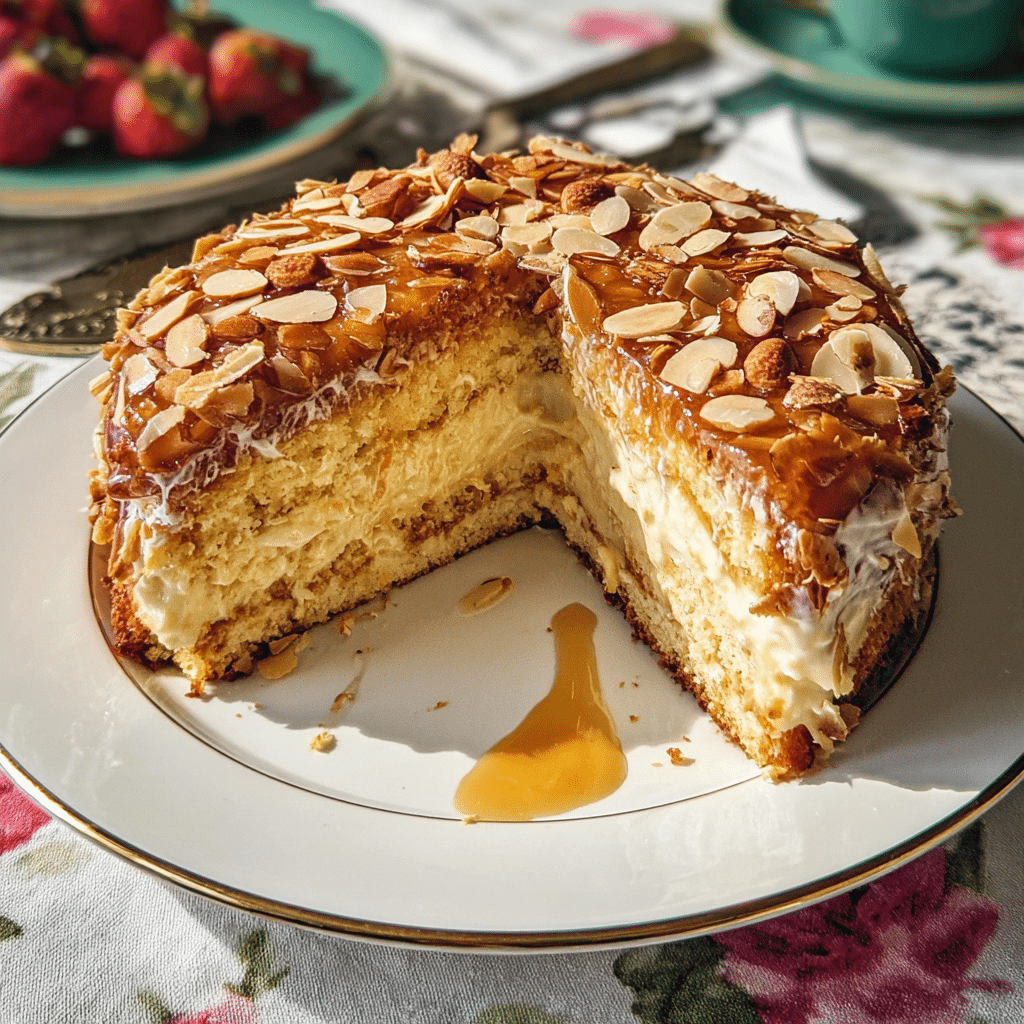Have you ever bitten into a dessert so perfect that it instantly transports you to another place and time? That’s exactly what happened to me during my culinary travels through Bavaria, when I first encountered Bee Sting Cake at a tiny bakery tucked away in Munich’s old quarter. The combination of pillowy yeast cake, silky pastry cream, and that signature almond-honey topping created a flavor symphony that I knew I had to recreate.
Hey there! I’m Emeli, and after years of perfecting this traditional German dessert in my own kitchen, I’m excited to share this Bee Sting Cake recipe that brings together the best of European baking traditions with techniques that work beautifully in home kitchens. This isn’t just another cake recipe—it’s a journey into one of Germany’s most beloved desserts, complete with pro tips I’ve learned from both professional kitchens and countless home baking sessions.
In this guide, you’ll discover the secrets to creating the perfect yeast-based cake, mastering that iconic almond topping, and assembling a dessert that looks as stunning as it tastes. We’ll cover ingredient selection, step-by-step techniques, troubleshooting tips, and even some delicious variations to make this recipe your own.
Why This Bee Sting Cake Recipe Works
There’s something magical about a dessert that combines multiple textures and flavors into one harmonious bite, and that’s exactly what makes this Bee Sting Cake recipe so special. After years of testing and refining, I’ve discovered the key elements that make this German classic irresistible:
• Uses simple, pantry-friendly ingredients that you can find at any grocery store—no need for specialty items or hard-to-source European ingredients • Combines three distinct layers of flavor and texture: tender yeast cake, silky pastry cream, and crunchy caramelized almond topping • Perfect for special occasions yet approachable enough for weekend baking adventures when you want to try something new • Impressive presentation that looks like it came from a professional bakery but uses techniques any home baker can master
Choosing the Right Ingredients for Bee Sting Cake Recipe
The beauty of this Bee Sting Cake recipe lies in how each component builds upon the others, which means ingredient quality and selection really matter. Let me walk you through what makes the difference between good and extraordinary.
Essential Cake Base Ingredients for Bee Sting Cake Recipe
The foundation of any great Bee Sting Cake starts with the yeast-based cake itself. Unlike typical American cakes that rely on chemical leaveners, this European-style cake uses yeast for a uniquely tender, slightly chewy texture that’s absolutely divine.
Flour combination is crucial: The blend of all-purpose and bread flour creates the perfect texture—bread flour provides structure and chew, while all-purpose flour keeps it tender. Don’t substitute with just one type; the combination is what makes this cake special.
Fresh yeast vs. instant yeast: While traditional recipes call for fresh yeast, instant yeast works beautifully and is much more convenient for home bakers. The key is making sure it’s fresh and active.
Pastry Cream Components for Bee Sting Cake Recipe
The filling is where this cake truly shines, combining classic pastry cream with lightened whipped cream for a texture that’s both rich and airy.
Vanilla bean paste over extract: This single swap elevates the entire dessert. The vanilla specks add visual appeal, and the intensity of flavor is incomparable to regular extract.
Gelatin for stability: The small amount of unflavored gelatin ensures your cream filling holds its shape beautifully, even in warm weather.
Signature Almond Topping for Bee Sting Cake Recipe
This is what gives Bee Sting Cake its name and iconic appearance—the golden, caramelized almond layer that resembles a honeycomb.
Sliced almonds work best: They create the perfect texture and appearance. Avoid slivered or chopped almonds, which won’t give you that traditional look.
Quality honey matters: Since honey is a key flavor component, choose one you’d enjoy eating on its own. Wildflower or clover honey work beautifully.
Ingredients & Prep for Bee Sting Cake Recipe
Creating this Bee Sting Cake recipe is like conducting an orchestra—timing and preparation are everything. Let me break down each component so you can approach this with confidence.
Cake Base Preparation for Bee Sting Cake Recipe
The yeast dough requires some patience, but the hands-on time is minimal. The key is creating the right environment for your dough to rise properly.
Temperature matters: Your milk and butter mixture should be warm to the touch (around 110°F) but not hot, which would kill the yeast. Think baby bottle temperature—warm but not scalding.
Proper mixing technique: Don’t overmix the dough initially. Start with a wooden spoon until it just comes together, then let your stand mixer do the work. The dough should be smooth but still slightly sticky when ready.
Pastry Cream Mastery for Bee Sting Cake Recipe
This is where many home bakers get nervous, but I’m here to guide you through it. The secret is constant whisking and patience.
The towel trick: That kitchen towel circle isn’t just fancy technique—it keeps your bowl steady while you whisk in the hot milk, preventing scrambled eggs and ensuring smooth cream.
Straining is essential: Even if your cream looks perfectly smooth, pass it through a fine-mesh strainer. This removes any small lumps and creates that silky, professional texture.
Advanced Timing Tips for Bee Sting Cake Recipe
Here’s how to orchestrate the timing so everything comes together perfectly:
- Start with the pastry cream (it needs the longest chilling time)
- While cream chills, make and rise your dough
- Prepare the almond topping just before baking
- Assemble when everything is completely cool

Step-by-Step Cooking Instructions for Bee Sting Cake Recipe
Now comes the fun part! Let’s walk through each step of this Bee Sting Cake recipe with the detail and confidence that comes from years of making this dessert.
Pre-Cooking Prep for Bee Sting Cake Recipe
Set up your workspace: Clear counter space for kneading, prepare your cake pan with cooking spray and parchment, and gather all ingredients. This recipe moves quickly once you start, so preparation is key.
Warm environment for rising: If your kitchen is cool, create a warm spot by turning your oven on for just 1 minute, then turning it off and placing your rising dough inside with the door slightly ajar.
Cooking Method for Bee Sting Cake Recipe
The dough mixing process: Start by heating your milk and butter until the butter nearly melts, then combine with eggs and dry ingredients. The stand mixer transforms this sticky mess into smooth, elastic dough in about 6 minutes.
First rise timing: Look for the dough to become puffy but not quite doubled—this usually takes about an hour in a warm kitchen. Over-proofed dough will make a dense cake.
Shaping in the pan: Press the dough evenly to the edges of your prepared pan. If it springs back, let it rest 5 minutes before trying again—the gluten needs time to relax.
Doneness Check for Bee Sting Cake Recipe
Visual cues: The cake is ready when it’s puffed and golden-brown, and the almond topping is deeply caramelized. The edges should pull slightly from the sides of the pan.
The knife test: Immediately run a thin knife around the edges while the cake is hot—this prevents the sticky almond topping from gluing itself to the pan.
Resting for Bee Sting Cake Recipe
Cooling is crucial: Let the cake cool 20 minutes in the pan, then flip it out and cool completely on a wire rack. Cutting too soon will result in a gummy texture and filling that won’t hold its shape.
Assembly timing: Wait until everything is completely cool before assembling. The contrast between the cool, creamy filling and room-temperature cake is part of what makes this dessert so special.
Pro Tips for Perfect Bee Sting Cake Recipe
After making countless Bee Sting Cakes, I’ve learned the small details that separate good from extraordinary. These are my hard-earned secrets for bakery-quality results every time.
Avoiding Common Pitfalls in Bee Sting Cake Recipe
Dense cake troubleshooting: If your cake turns out heavy, the most likely culprit is over-proofed dough or inactive yeast. Always check your yeast’s expiration date and proof it in warm liquid before using.
Preventing weepy filling: The gelatin in the whipped cream isn’t optional—it’s what keeps your beautiful assembly from turning into a soggy mess. Dissolve it completely and incorporate it while still warm.
Almond topping success: Cook the honey-butter mixture until it’s bubbling and slightly darkened before adding almonds. This ensures proper caramelization and prevents a pale, soggy topping.
Essential Tool Recommendations for Bee Sting Cake Recipe
Stand mixer necessity: While you could make this by hand, a stand mixer makes the dough development effortless and ensures consistent results every time.
Quality cake pan: An 8 or 9-inch round pan with straight sides works best. Light-colored metal conducts heat evenly and prevents over-browning.
Fine-mesh strainer: This is what transforms homemade pastry cream from good to professional-quality. Don’t skip this step.
Storage & Make-Ahead Tips for Bee Sting Cake Recipe
Component preparation: Both the pastry cream and cake base can be made a day ahead. Store the cream covered in the refrigerator and the cooled cake wrapped in plastic wrap.
Freezing options: The unfilled cake freezes beautifully for up to 3 months. Wrap tightly in plastic wrap, then aluminum foil. Thaw completely before filling.
Serving timeline: Once assembled, this cake is best served within 24 hours for optimal texture and appearance.
Flavor Variations for Bee Sting Cake Recipe
One of the things I love most about this Bee Sting Cake recipe is how it serves as a canvas for creativity. Here are some delicious variations I’ve developed over the years.
Classic Twist Variations for Bee Sting Cake Recipe
Chocolate Bee Sting: Replace 1/4 cup of the all-purpose flour with unsweetened cocoa powder for a subtle chocolate base that pairs beautifully with the almond topping.
Lemon-Scented Version: Add the zest of one lemon to both the cake batter and pastry cream for a bright, citrusy note that lightens the richness.
International Inspired Bee Sting Cake Recipe
French Vanilla: Use vanilla bean seeds scraped from a whole pod instead of vanilla bean paste, and add a tablespoon of brandy to the pastry cream.
Italian Twist: Incorporate a thin layer of mascarpone mixed with a touch of amaretto into the filling for extra richness and almond flavor.
Dietary Adaptation for Bee Sting Cake Recipe
Gluten-Free Option: Substitute the flour blend with a 1:1 gluten-free baking flour, but add 1/2 teaspoon xanthan gum if your blend doesn’t include it.
Reduced Sugar: Cut the granulated sugar in the cake by half and use sugar-free honey alternative in the topping, though the texture will be slightly different.
Here’s a helpful comparison of the variations:
| Variation | Key Changes | Flavor Profile | Difficulty Level |
|---|---|---|---|
| Classic | None | Traditional honey-almond | Beginner |
| Chocolate | Add cocoa powder | Rich, slightly chocolate | Beginner |
| Lemon | Add lemon zest | Bright, citrusy | Beginner |
| French Vanilla | Vanilla bean, brandy | Sophisticated, boozy | Intermediate |
| Italian | Mascarpone, amaretto | Rich, almond-forward | Intermediate |
| Gluten-Free | Alternative flour blend | Similar to classic | Advanced |
Serving Suggestions for Bee Sting Cake Recipe
The beauty of this Bee Sting Cake recipe lies not just in its incredible taste, but in its versatility for different occasions and pairings.
Perfect presentation: Slice with a sharp, clean knife, wiping between cuts to keep the layers distinct and beautiful. Dust with a light sprinkle of powdered sugar just before serving for an elegant finish.
Ideal accompaniments: Serve alongside fresh berries and a dollop of lightly sweetened whipped cream. The tartness of berries provides a lovely contrast to the rich, sweet cake. A cup of strong coffee or espresso complements the honey and almond flavors perfectly.
Wine and beverage pairings: For special occasions, pair with a dessert wine like Moscato or Riesling. The wine’s acidity cuts through the richness beautifully. For everyday enjoyment, serve with German-style coffee or even a chai tea latte that echoes the warm spice notes.
FAQs for Bee Sting Cake Recipe
After sharing this Bee Sting Cake recipe with hundreds of home bakers, these are the questions I hear most often.
Can I make this cake ahead of time? Absolutely! The individual components can be made up to 2 days ahead, but assemble the cake no more than 24 hours before serving for the best texture. The cake actually improves slightly as the flavors meld.
What if I don’t have instant yeast? You can substitute active dry yeast, but you’ll need to proof it first. Dissolve the yeast in the warm milk mixture and let it foam for 5 minutes before proceeding with the recipe.
Why is my almond topping not crunchy? This usually happens when the honey-butter mixture isn’t cooked long enough before adding the almonds. Make sure it’s actively bubbling and slightly darkened before stirring in the nuts.
Can I use a different pan size? An 8-inch pan will give you a taller cake, while a 9-inch creates a slightly thinner version. Both work beautifully—just adjust baking time by 2-3 minutes accordingly.
Is this recipe safe for pregnant women? Yes, all ingredients are fully cooked or pasteurized. The pastry cream reaches safe temperatures during cooking, and there’s no raw egg in the final product.
How do I fix lumpy pastry cream? If your cream develops lumps during cooking, strain it immediately through a fine-mesh sieve while still warm, pressing the mixture through with a spatula. This fixes almost any texture issues.
Conclusion
There’s something truly magical about mastering a classic recipe like this Bee Sting Cake—it connects you to generations of bakers and brings a piece of German tradition into your own kitchen. From that first bite of tender yeast cake through the creamy filling to that signature crunchy almond topping, every element works in perfect harmony.
Fire up your oven and embark on this baking adventure today! This isn’t just about following a recipe; it’s about creating memories, surprising loved ones, and adding a stunning European dessert to your baking repertoire. The techniques you’ll master here—from working with yeast dough to creating silky pastry cream—will elevate your baking skills for years to come.
Join the thousands of home bakers who’ve fallen in love with this recipe! I’d love to see your beautiful creations and hear about your own baking adventures. Share your photos and stories—there’s nothing I enjoy more than seeing this traditional recipe bring joy to new kitchens around the world.
Ready for your next baking challenge? Try our [Authentic German Stollen Guide] or [Classic European Tortes Collection] next! Once you’ve mastered the techniques in this Bee Sting Cake, you’ll be ready to tackle even more impressive European desserts that will make your kitchen the heart of every celebration.
If you enjoyed this recipe, be sure to share it with your friends or save it for later!
I’d love to see your unique twist—feel free to post your photos on Pinterest!
Happy baking, and remember—the best recipes are the ones shared with love.
– Emeli
Founder & Chef at FoodFansy.com

Bee Sting Cake Recipe: Ultimate 3-Layer German Dessert (Easy!)
- Total Time: 1hr 40mins
Ingredients
For the cake:
Cooking spray
4 tablespoons (1/2 stick) unsalted butter
1/4 cup whole milk
2 large eggs
1 cup all-purpose flour, plus more for the work surface
1 cup bread flour
1/4 cup granulated sugar
1 (1/4-ounce) packet instant yeast
1/2 teaspoon kosher salt
For the pastry cream and filling:
1 cup whole milk, divided
4 tablespoons granulated sugar, divided
1 teaspoon vanilla bean paste
1 pinch kosher salt
2 tablespoons cornstarch
2 large egg yolks
1 tablespoon unsalted butter
4 teaspoons water
3/4 teaspoon powdered unflavored gelatin
3/4 cup cold heavy cream
3 tablespoons powdered sugar
For the topping:
4 tablespoons (1/2 stick) unsalted butter
3 tablespoons honey
3 tablespoons granulated sugar
1/2 teaspoon vanilla bean paste
1 pinch kosher salt
1 cup sliced almonds
Instructions
Make the cake:
Coat an 8- or 9-inch round cake pan and a large bowl with cooking spray. Line the bottom of the cake pan with a parchment paper round.
Dice 4 tablespoons unsalted butter. Place the butter and 1/4 cup whole milk in a small saucepan. Heat over medium-low heat until the butter is almost melted and the milk is hot to the touch (about 110ºF); swirl the pan to fully melt the butter. Transfer to the bowl of a stand mixer.
Lightly beat 2 large eggs in a small bowl until broken up. Add the eggs, 1 cup all-purpose flour, 1 cup bread flour, 1/4 cup granulated sugar, 1 (1/4-ounce) packet instant yeast, and 1/2 teaspoon kosher salt to the milk mixture. Stir with a wooden spoon until a sticky dough forms.
Fit the bowl onto the stand mixer. Mix with the hook attachment on medium speed until a smooth but still-sticky dough forms, 5 to 7 minutes. Scrape the dough into the oiled bowl. Cover the bowl with plastic wrap and let the dough rise in a warm place until puffy but not quite doubled in size, about 1 hour. Meanwhile, wash and dry the stand mixer bowl. Make the pastry cream.
Make the pastry cream:
Fit a fine-mesh strainer over a medium bowl. Place 3/4 cup of the whole milk, 2 tablespoons of the granulated sugar, 1 teaspoon vanilla bean paste, and 1 pinch kosher in a medium saucepan. Whisk to combine and place over medium-low heat.
While the milk mixture is heating, roll up a kitchen towel lengthwise, then make the ends meet to form a circle. Place the remaining 1/4 cup whole milk, remaining 2 tablespoons granulated sugar, and 2 tablespoons cornstarch in a second medium bowl. Whisk until smooth. Add 2 large egg yolks and whisk until lightened in color. Place this bowl in the center of the towel circle.
Once the milk mixture on the stove comes to a simmer, pour half of it into the egg yolk mixture in a steady stream while whisking constantly (the towel should hold the bowl steady while you whisk). While whisking constantly, pour the yolk mixture back into the saucepan. While whisking constantly, bring back to a simmer and cook until thickened, about 5 minutes.
Turn off the heat. Add 1 tablespoon unsalted butter and whisk until the butter is melted and the mixture is smooth. Scrape into the fine-mesh strainer and press the mixture through with a flexible spatula, making sure to scrape the underside of the strainer; discard the contents of the strainer.
Press a sheet of plastic wrap directly onto the surface of the pastry cream to prevent a skin from forming. Refrigerate until cold, about 1 hour and 15 minutes. Meanwhile, bake the cake.
Make the cake:
Lightly dust a work surface with all-purpose flour. Transfer the dough onto the work surface. Degas the dough by pressing down to release any large air bubbles. Loosely shape into a ball and place in the cake pan. Press the dough evenly in the pan, going all the way to the edges (if it springs back, let rest for 5 minutes before trying again).
Cover with plastic wrap and let rise in a warm spot until slightly puffed, about 30 minutes. Meanwhile, arrange a rack in the middle of the oven and heat the oven to 350ºF.
Make the topping:
Make the topping when the dough is ready. Place 4 tablespoons unsalted butter, 3 tablespoons honey, 3 tablespoons granulated sugar, 1/2 teaspoon vanilla bean paste, and 1 pinch kosher salt in a small saucepan. Stir to combine and bring to a simmer over medium heat. Add 1 cup sliced almonds and stir to combine.
Dollop the mixture over the dough and spread into an even layer. Place the cake pan on a baking sheet. Bake until puffed and golden-brown, 30 to 32 minutes. Immediately run a thin knife around the cake to keep the topping from sticking. Let cool for 20 minutes in the pan.
Flip the cake out of the pan, remove the parchment, and place the cake right-side up on a wire cooling rack. Let cool completely, about 1 hour more.
Make the filling:
Place 4 teaspoons water in a small microwave-safe bowl and sprinkle 3/4 teaspoon powdered unflavored gelatin over the water. Let sit for 5 to 10 minutes. Meanwhile, place the pastry cream in the stand mixer bowl and beat with the paddle attachment on medium speed until smooth and spreadable, about 2 minutes. Return the pastry cream to the bowl it was chilled in.
Microwave the gelatin mixture until melted, about 10 seconds. Place 3/4 cup cold heavy cream and 3 tablespoons powdered sugar in the stand mixer (no need to clean first). Fit with the whisk attachment and turn on to low speed. Slowly add the melted gelatin. Once incorporated, increase the speed to medium-high and whip until stiff peaks form, about 2 minutes.
Transfer about 1/3 of the whipped cream into the pastry cream and stir with a flexible spatula until smooth. Add the remaining whipped cream and gently fold until just combined.
Slice the cake in half horizontally. Place the bottom half of the cake cut-side up on a cake stand or serving plate. Transfer the filling onto the cake and spread into an even layer, going all the way to the edges. Let sit for 2 minutes. Top with the top half of the cake cut-side down. Refrigerate until the filling is set, about 1 hour.
Notes
Make ahead: The cake can be baked and frozen up to 1 month ahead; thaw before using. The pastry cream can be made up to 4 days ahead and refrigerated; just be sure to keep plastic wrap directly on the surface and do not add the whipped cream until ready to assemble.
Storage: Cover and refrigerate leftovers for up to 4 days.
- Prep Time: 1hour
- Cook Time: 40minutes
- Category: Desssert
Nutrition
- Calories: 452kcal
- Sugar: 23g
- Sodium: 188mg
- Fat: 26.2g
- Saturated Fat: 12.3g
- Fiber: 2 g
- Protein: 8.8g
Keywords: Bee Sting Cake Recipe

